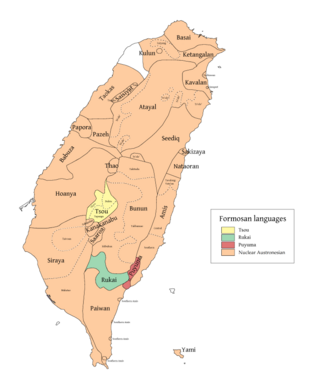| Puyuma | |
|---|---|
| Pinuyumayan | |
| Native to | Taiwan |
| Ethnicity | Puyuma people |
Native speakers | 8,500 (2002)[1] |
Austronesian
| |
| Language codes | |
| ISO 639-3 | pyu |
| Glottolog | puyu1239 |
| ELP | Puyuma |
| Linguasphere | 30-JAA-a |
 (red) Puyuma | |
 Puyuma is classified as Vulnerable by the UNESCO Atlas of the World's Languages in Danger | |
The Puyuma language or Pinuyumayan (Chinese: 卑南語; pinyin: Bēinányǔ), is the language of the Puyuma, an indigenous people of Taiwan. It is a divergent Formosan language of the Austronesian family. Most speakers are older adults.
Puyuma is one of the more divergent of the Austronesian languages and falls outside reconstructions of Proto-Austronesian.
The internal classification of Puyuma dialects below is from Ting (1978). Nanwang Puyuma is considered to be the relatively phonologically conservative but grammatically innovative, as in it preserves proto-Puyuma voiced plosives but syncretizes the use of both oblique and genitive case.[2]
Puyuma-speaking villages are:[3]
Puyuma has 18 consonants and 4 vowels:
| Bilabial | Alveolar | Retroflex | Palatal | Velar | Glottal | ||
|---|---|---|---|---|---|---|---|
| Nasal | m | n | ŋ ⟨ng⟩ | ||||
| Plosive | Voiceless | p | t | ʈ ⟨tr⟩ | k | ʔ ⟨’⟩ | |
| Voiced | b | d | ɖ ⟨dr⟩ | ɡ | |||
| Fricative | s | ||||||
| Trill | r | ||||||
| Approximant | l ⟨lr⟩ | ɭ ⟨l⟩ | j ⟨y⟩ | w | |||
| Front | Central | Back | |
|---|---|---|---|
| Close | i | u | |
| Mid | ə ⟨e⟩ | ||
| Open | a |
Note that Teng uses ⟨lr⟩ for /ɭ/ and ⟨l⟩ for /l/, unlike in official version. The official orthography is used in this article.
Puyuma verbs have four types of focus:[5]
There are three verbal aspects:[5]
There are two modes:[5]
Affixes include:[5]
| Active | Patient | Locative | Causative | ||
|---|---|---|---|---|---|
| Realis | Unmarked | tremakaw | trakawaw | trakaway | trakawanay |
| Progressive | trematrakaw | tratrakawaw | tratrakaway | tratrakawanay | |
| Durative | trematratrakaw | tratratrakawaw | tratratrakaway | tratratrakawanay | |
| Irrealis | tratrakaw | tratrakawi | tratrakawan | ||
| Imperative | trakaw | trakawi | trakawu | trakawan | |
| Hortative | tremakawa | — | |||
Puyuma has a verb-initial word order.
Articles include:[7]
The Puyuma personal pronouns are:[8]
| Type of Pronoun |
Nominative[9] | Oblique: Direct |
Oblique: Indirect |
Oblique: Non-Subject |
Neutral |
|---|---|---|---|---|---|
| 1s. | nanku | kanku, kananku | draku, drananku | kanku | kuiku |
| 2s. | nanu | kanu, kananu | dranu, drananu | kanu | yuyu |
| 3s. | nantu | kantu, kanantu | dratu, dranantu | kantaw | taytaw |
| 1p. (incl.) | nanta | kanta, kananta | drata, drananta | kanta | taita |
| 1p. (excl.) | naniam | kaniam, kananiam | draniam, drananiam | kaniam | mimi |
| 2p. | nanemu | kanemu, kananemu | dranemu, drananemu | kanemu | muimu |
| 3p. | nantu | kantu, kanantu | dratu, dranantu | kantaw | – |
| Type of Pronoun |
Nominative (Subject) |
Nominative (Possessor of subject) |
Genitive |
|---|---|---|---|
| 1s. | =ku | ku= | ku= |
| 2s. | =yu | nu= | nu= |
| 3s. | – | tu= | tu= |
| 1p. (incl.) | =ta | ta= | ta= |
| 1p. (excl.) | =mi | niam= | mi= |
| 2p. | =mu | mu= | mu= |
| 3p. | – | tu= | tu= |
The Puyuma affixes are:[10]